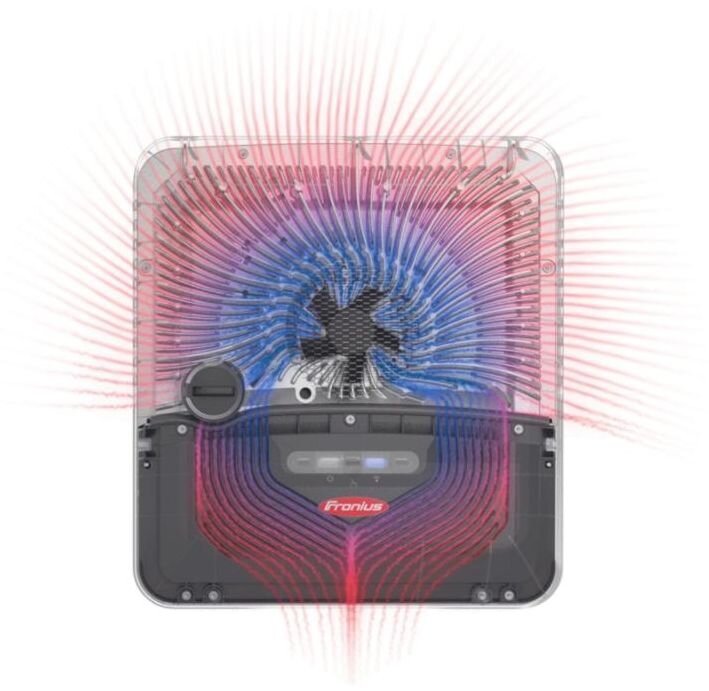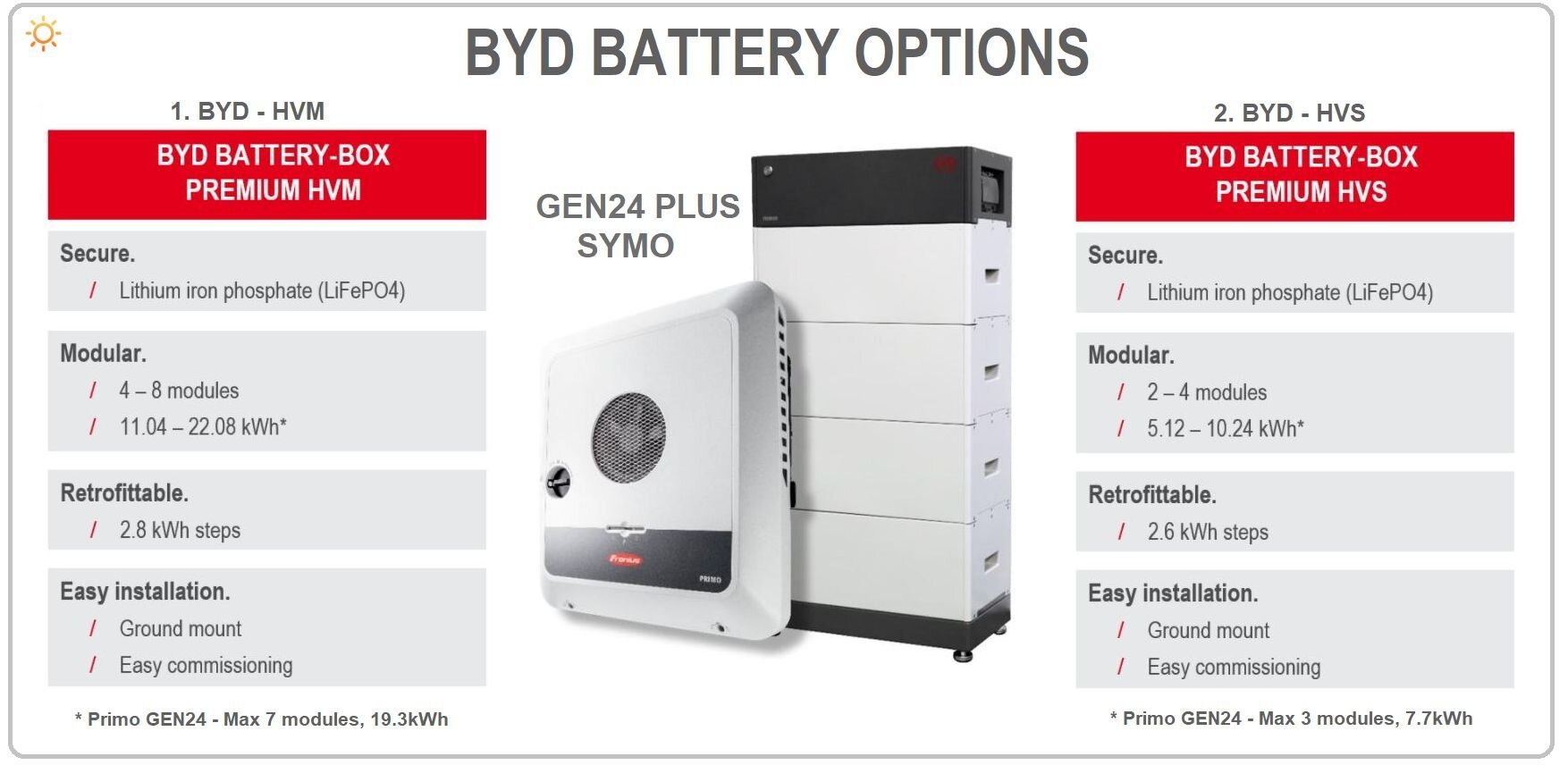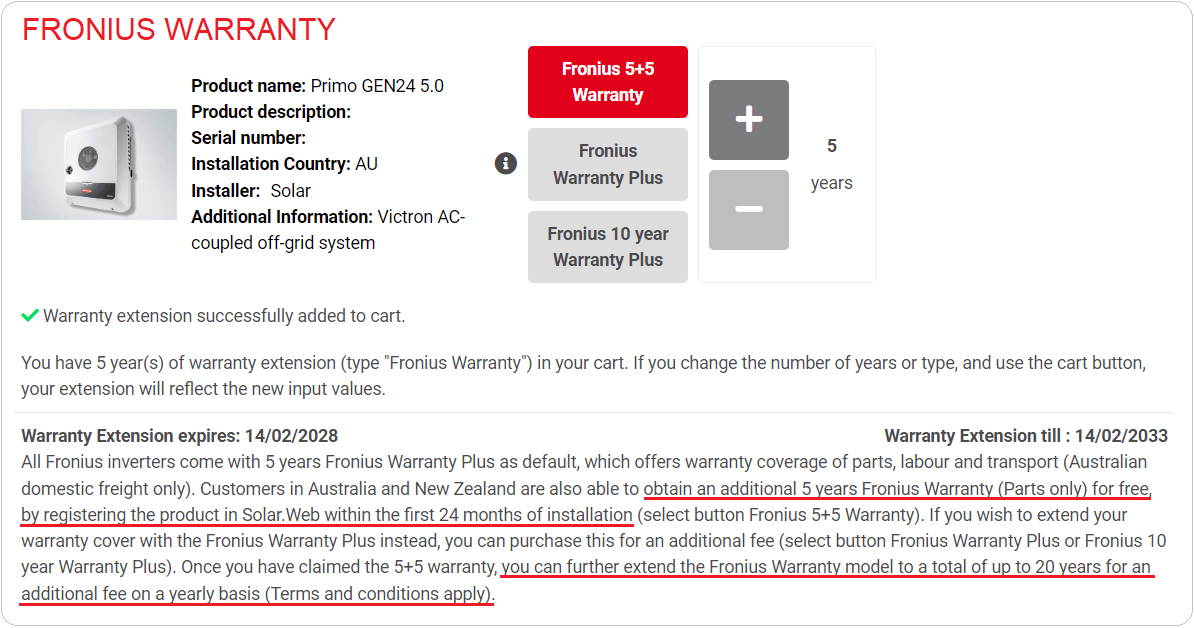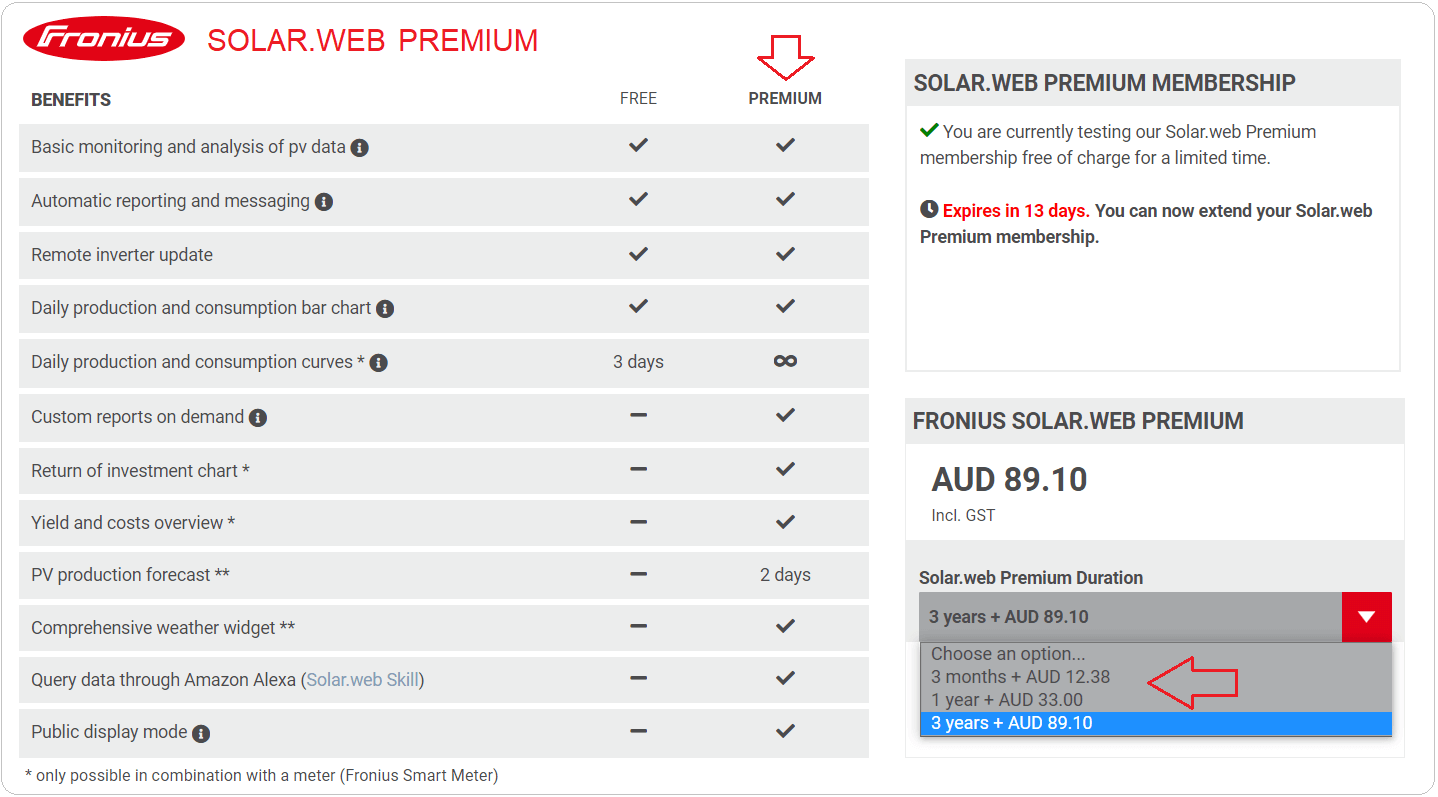Fronius Inverter Review
home > solar inverters > best inverters review > Fronius Inverter Review
Fronius Inverters Quick Summary
First established: 1994 - Long-standing company
Best Solar inverter: GEN24 series up to 10kW
Best Hybrid inverter: GEN24 Plus series up to 10kW
Price bracket: High $$$$$
Warranty: Standard - 10 years (5 full + 5 parts only)
Quality and reliability: Excellent 5/5
Service and support: Excellent 5/5
System Monitoring: Very Good 4.5/5
Overall: Highly Recommended ☆☆☆☆☆
Company History
Fronius is highly regarded in the solar world and is generally considered the world’s leading string solar inverter manufacturer. This reputation is not based on sales volume, but on service, quality and, most importantly, reliability. With the solar inverter being the most complex component in any solar system, it is also the part most likely to develop problems. Inverter faults can be extremely frustrating for installers and customers alike and often result in complete system shutdown, hence why reliability is crucial.
All Fronius solar inverters are engineered, designed and manufactured in Austria. With over half a century of experience in inverter (welder) design and manufacturing, it’s not surprising Fronius is considered an industry leader in power conversion equipment. Fronius’s history in designing high-performance welding inverters provided the ideal background for moving into solar inverter production over two decades ago, with the first Fronius solar inverter released in 1994.
Fronius continued to develop a number of solar inverters, but it wasn’t until the release of the snap-in inverter (snapINverter) range in 2012 that Fronius really created a stir and quickly developed a strong following around the world. Up until this point, SMA was widely regarded as the industry leader. SMA experienced some issues during the transition to the new generation AV series inverters and lost a lot of ground to Fronius. However, they are one of the few manufacturers which can still compete with Fronius on quality and reliability.
Fronius Snap-in Primo Inverters
Residential single-phase string inverters from 3kW to 8.2kW
The Fronius Primo ‘SnapINverters’ surged in popularity after the release of the new design nine years ago and are widely regarded as one of the best quality and most reliable residential string solar inverters. While larger and heavier than most modern inverters available today at 21.5kg, the unique snap-in design makes installation and servicing easy. Inverter monitoring and setup are quick and easy via the large clear display and four multi-function buttons.
Primo inverters are cooled via an active cooling system using fan-forced air. Active cooling, while being a little more complex, is claimed to increase performance and reliability when compared to the more common passive cooling systems. As further examined below, we believe this is a key reason behind Fronius’s reliability and low recorded failure rate.
Key features
Unique Snap-in design for easy installation & service
High input current - 18A per MPPT (5kW+ SC version)
Integrated DC isolator (CEC certified)
Fan-forced active cooling system
External relay control - Digital output
The Primo range of single-phase transformerless inverters are available in a wide range of power ratings from 3.0kW to 8.2kW, all featuring dual MPPT inputs and a high input voltage limit of 1000V. More importantly, the larger inverters, rated 5kW and above, have a high input current rating of 18A per MPPT and Isc of 27A. This allows two strings of panels to be connected in parallel. Note, this is now referred to as the Superior Current (SC) version in Australia.
Download the Fronius Primo Snap-in Inverter datasheet.
Fronius GEN24 Primo Inverter
Residential single-phase string inverters from 3.0kW to 10.0kW
The GEN24 Primo series is the next evolution in the Primo range based on the popular GEN24 Plus hybrid inverter. In fact, the GEN24 Primo is virtually identical to the hybrid version; only the battery connection is disabled. For an additional cost, the inverter can be upgraded to a GEN24 Plus (hybrid) version via a special firmware update using the Solar.web monitoring portal. If the owner decides to add battery storage in the future, it is an easy over-the-air update. However, additional parts will be required to enable full backup power.
The GEN24's unique design and central-mounted fan created quite a stir when it was first released. However, the retro design hides many advanced engineering features and functions, including enhanced active cooling, easy access DC isolator, internal snap-fit connections, and easy disassembly and servicing.
GEN24 Inverter features and highlights
Wide MPPT voltage range - 65V to 530V (up to 480V for 6 - 10kW models)
High input current 3-6kW models - 22A / 12A (Isc 36A / 19A)
Very high input current 8-10kW models - 22A / 22A (Isc 41A / 36A)
Over-sizing solar arrays up to 150%
Fan-forced active cooling system with front heat shield
Arc fault detection (US only)
Integrated DC isolator (CEC certified)
External relay control - Digital output
Easy auto Wifi connection using a one-touch WPS button
No tool, spring clip internal cable connections
Rear access and large internal cable area for neat installs
Easy inverter service and exchange of parts
Fast cover removal - access via 180 locking screws
Download the Fronius GEN24 Primo 3-6kW datasheet.
Download the Fronius GEN24 Primo 3-10kW datasheet.
Fronius Symo and ECO Inverters
3-phase string inverters, 3.0kW to 27kW
The Fronius Symo three-phase inverters are built around the same snap-in design and are available in an impressive range of sizes to suit both residential and commercial applications. Symo inverters range from 3.0kW up to 20kW, while the ECO’s are available in 25kW or 27kW sizes. The GEN24 Symo is now also available in 3kW, 6kW and 10kW options.
Many commercial inverters are located in exposed locations and have to perform in extreme conditions, including high summer temperatures. This is where the Fronius active cooling system really shines enabling continuous operation with minimal power derating in high ambient temperatures up to 50 degC.
Download the Fronius Symo Inverter datasheet.
Key features
Unique Snap-in design for easy installation & service
High input current (ECO 27) = 47.7A (Isc max 71.6A)
Integrated DC isolator and DC string fusing.
Fan forced active cooling system.
External relay control - Digital output.
The Fronius ECO series are highly sought after for larger scale commercial systems due to the high performance, reliability, advanced communication options, and unique features such as the integrated string fusing. The integrated all-pole string fusing (fuses optional) mean string combiner boxes are no longer required making installation quicker and easier.
See the Fronius ECO Solar Inverter Specification sheet here.
Off-grid Solar with Fronius
Over the years, Fronius Primo and Symo inverters have become key features in many off-grid solar or stand-alone power systems. Primo and Symo (3-phase) inverters are string solar inverters, not battery inverters, but can be coupled with a compatible off-grid battery inverter-charger to form an advanced AC-coupled energy storage system.
*Fronius Primo solar inverter AC-coupled with the popular Selectronic SP PRO off-grid inverter-charger
AC-coupling for off-grid power systems has become the configuration of choice over recent years. The flexibility and simplicity of AC coupling allowed off-grid systems to become much larger and more powerful. Several years ago, Fronius made the clever move of teaming up with two of the leading off-grid inverter manufacturers, Selectronic and Victron Energy, to allow the Primo and Symo inverters to operate in both on-grid or off-grid systems.
*NOTE: The Fronius inverter must be ‘Selectronic certified’ to function in a ‘managed’ AC-coupled off-grid system. Selectronic certified or ‘Scert’ single-phase inverters are slightly modified to enable high-precision battery charge control. However, Victron AC-coupled off-grid systems use a standard Primo or Symo inverter and enable off-grid charge control using frequency shifting. This is adequate but not as precise and can affect some sensitive electronic appliances.
GEN24 Plus Hybrid inverters
Fronius designed and engineered an entirely new hybrid Inverter platform known as the GEN24 Plus. It was a long wait with the GEN24 Symo 3-phase version released in October 2020, while the Primo was released in May 2021. The GEN24 plus range is built around Fronius’s vision of ’24 hours of sun’, referring to the use of solar combined with energy storage to deliver power day and night for maximum self-sufficiency.
One of the unique features of the GEN24 Plus is the PV Point power function, which provides backup power, up to 3000VA (2.4kW), during the day without a battery. Since the PV point powers the backup loads directly by solar, the amount of backup power will vary throughout the day depending on the weather conditions. An adequately sized solar array could easily power smaller loads such as a fridge, lights, and laptops.
GEN24 Plus Inverter Features
Some standout features of the new inverter range include the extremely wide PV operating (MPPT) voltage range, which starts from a very low 65V for the Primo and 80V for the Symo. This means strings can be as small as three panels or up to 14, depending on the panel voltage.
Very wide MPPT voltage range - 65V to 530V
Dual MPPT trackers - 22A / 11A - Parallel strings ok
Very high battery efficiency - 94% round-trip with BYD Battery
PV point backup power without a battery - PV point (3kVA)
Full backup power with battery (22A) & external contactor
Over-sizing solar arrays up to 150%
Advanced active cooling system with front heat shield
Arc fault detection (US only)
The most obvious physical feature is the unique front-mounted fan giving it a surprisingly retro look. Although much more is behind the front cover, it hides a sophisticated thermal management system with a cleverly designed spiral heat sink. This active cooling system, described in more detail below, helps improve both performance and reliability. But it doesn’t stop there; the GEN24 Plus also features integrated grid backup and four digital inputs/outputs to take full advantage of smart home controls and load management. The one apparent deficiency is the lack of a display or buttons. Although, this has become an industry norm as inverters transition to app-based setup and monitoring.
Download the Fronius GEN24 Plus specifications datasheet
GEN24 Plus Battery Options
The GEN24 plus inverters are currently only compatible with BYD's higher voltage battery systems (Premium HVS & HVM models).
The GEN24 is currently only compatible with the BYD HVM and HVS batteries.
Quick installation and setup
Like the snap-in inverter range, the new Gen24 plus inverters have an enclosed cable/terminal connection area which makes installation much neater and easier for installer.
Throughout the long development process, Fronius was actively gathering feedback from solar installers about features that would make the installation and commissioning process quick and easy. This led to several innovative design features and a new mobile App which will no doubt make the new GEN24 plus series some of the easiest inverters to install and set up.
Fast 3-Step commissioning with the new Fronius App
Easy auto Wifi connection using one-touch WPS button
Fast cover removal - access via 180 locking screws
No tool, spring clip internal cable connections
Rear access & large internal cable area for neat installs
Easy inverter breakdown and exchange of parts
Active Cooling
Is active cooling the secret to long term reliability?
Like the current snap-in inverters, the new Gen24 Plus hybrid inverters use an active cooling system.
Unlike the majority of manufacturers, Fronius only design inverters with active or fan-forced cooling. Most inverters available today are transformerless and utilise large rear-mounted heat sinks which use natural convection to cool the inverter. This simple design, known as passive cooling, doesn’t rely on any moving parts such as fans which can fail over time. However, relying on passive cooling alone can be problematic, especially in higher temperatures or locations with low natural air circulation. While mounting a solar inverter in locations exposed to the sun should be avoided, it is sometimes not possible and this is where many ‘cheap’ inverters relying on passive cooling alone can fail. Mounting in exposed positions with full sun (especially during the afternoon), heats the inverter to extreme levels and can cause severe power derating, thermal shutdown, and early failure
Fronius only use fan-forced active cooling which extracts heat at a more constant rate. As highlighted in the chart below, this can increase performance with less power ‘derating’ in high ambient temperatures. Power electronics have a maximum operating temperature after which the power transfer needs to be reduced to prevent overheating and potential damage. This is where active cooling can dramatically improve reliability. Fans can also fail; however, modern brushless DC fans have a very long lifespan. If a fan replacement is required, then it is easier to replace a fan rather a blown transistor or capacitor which may be impossible.
Fronius Inverter power derating at different temperatures and string voltages
Adequate cooling is essential for increasing the life of any electronic product. It is particularly crucial for solar inverters that use sophisticated power electronics to transfer thousands of watts of power in extreme environments. Modern inverters use solid-state transistors (semiconductors) to convert DC power from solar to AC power. High temperatures will reduce the efficiency, performance, and life of transistors and most other electrical components.
The new generation Fronius Symo hybrid solar inverter with the front cover removed, revealing the advanced spiral heat sink design.
Based on the long development time and vigorous testing, we are confident the Fronius engineers have designed the new GEN24 inverters to be extremely reliable, efficient, and offer high performance in all conditions. Looking at the GEN24 Plus specification sheet, it appears the new inverters have a high tolerance to being located in exposed locations with little protection.
Fan Noise
Naturally, using fans for cooling creates some level of noise. As the inverter's internal temperature increases, so too does the fan speed and associated fan noise. For most installations, the relatively low fan noise, which is reported to reach a maximum of 65 dB(A) for the older snap-in inverter range, is not an issue. However, if installed outside in specific locations, such as outside a bedroom window, the noise may be problematic as the fan can start cooling early in the morning, soon after sunrise. In this situation, a long sleep-in on a hot summer morning might be more difficult with the window open. The new GEN24 inverters have a more efficient cooling system and a much lower fan speed meaning the sound level is extremely low at less than 42 dB(A).
Warranty & Service
In regards to service, Fronius has ranked very highly for many years due to the low failure rates and great service. If a failure occurs, they usually ship replacement units in 3-5 business days. Fronius inverters are available with either a 5 or 10-year warranty as standard, depending on the location or country. The warranty period can be extended up to 20 years by paying additional annual fees. However, the regular warranty is 5+5 years, meaning the inverter is covered by a full parts, labour and transport (shipping) warranty for the first 5 years but only parts for the following 5 years. The limited 5-year parts-only warranty can be problematic for both customers and installers as the cost of shipping and labour needs to be negotiated.
In most countries, all Fronius string inverters come with five year Fronius Warranty Plus. Customers can obtain an additional free, 2 to 5-year extended warranty when the inverter is registered online via www.solarweb.com. This provides a free 10-year warranty period in Australia and some other countries.
Fronius solar inverter warranty details and options
Monitoring – Solar Web
The smart meter. Required for both solar & energy consumption monitoring. (single phase meter shown)
Wifi monitoring comes standard with all inverters via the Fronius Solar.Web. The addition of the Fronius smart meter enables monitoring of energy generation and consumption and can be used as a complete home energy monitoring system. A free Solar.web smartphone app is also available for android or iOS.
There is also the option of adding the Fronius Ohmpilot which is designed to automatically use excess solar energy to heat water.
The Fronius Solar.web app is a simple, easy-to-use app that displays the current solar generation and estimated savings. Digging a little deeper into the analysis section, users can chart detailed operating statistics like string current, voltage and grid voltage. Up to 3 days of consumption monitoring data can be accessed, but unfortunately, full consumption and generation history cannot be accessed without a premium subscription to Fronius Solar.web, described in more detail below.
Fronius Solar. Web portal - Image credit Fronius
The Solar.web premium upgrade offers an array of financial insights and additional data, but considering many competing platforms offer usage and generation history for free, this is a little disappointing. However, it offers other unique features, including a weather-based PV production forecast. In Australia, the cost is AU$33 per year, or AU$89 for three years which isn’t too excessive, but there should be longer options available with a greater discount.
Fronius Solar.web features compared to Solar.web Premium
Conclusion
From reading this review, it’s obvious why Fronius is widely considered a leading solar inverter manufacturer. When you sum it up, the reasons are pretty simple - high build quality, proven performance and reliability from an experienced manufacturer. The only real problem is getting hold of one is often tricky due to the limited supply and high demand.
The decision to engineer active cooling into all inverter platforms seems to have paid off by providing a higher level of performance and reliability, especially in extreme environments. The clever snap-in design, advanced communications, and features such as the integrated DC isolator and string fusing won over many installers. This, together with a high level of service and support, means any issues have been promptly addressed. In an industry plagued by cheap, unreliable inverters, this kind of service and reliability is essential.
Energy storage was one area where Fronius had been lacking in the past, but this has now changed with the GEN24 Plus inverters. The rapid evolution of hybrid inverter technology over the last 5 to 6 years has seen many manufacturers rush out inferior and problematic products with multiple issues. In some ways, this may have benefited Fronius, who doesn’t rush through development. The slow and steady approach to designing new inverters has resulted in Fronius producing one of the most advanced hybrid battery storage inverters, with clever load management and control features well suited to modern smart homes.
While Fronius offers fantastic, high-quality inverters, one of our few criticisms is the subscription cost for the Solar.web Premium system monitoring, which seems to offer very little considering many competing brands offer the same information, including solar performance and full history, for free.















